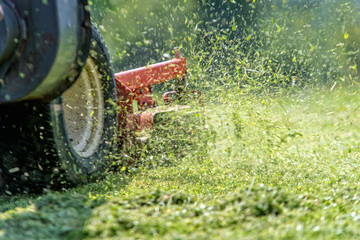A well-kept lawn is one of the most noticeable features of any home. Beyond aesthetics, a neatly mowed yard creates a welcoming atmosphere, improves property value, and promotes healthier grass growth. Lawn mowing might seem like a simple task, but the way you mow can make a big difference in how lush, green, and resilient your lawn becomes. By following the right techniques and routines, you can keep your yard looking vibrant throughout the year.

Why Lawn Mowing Matters
Lawn mowing is more than just cutting grass—it is an essential part of lawn care. Regular mowing encourages grass to grow thicker, making it harder for weeds to invade. It also helps maintain an even surface, reduces pests hiding in tall grass, and enhances the overall appearance of your outdoor space. Proper mowing not only keeps your lawn neat but also improves its long-term health.
Best Time to Mow Your Lawn
Timing is an important factor when it comes to lawn mowing. The best time of day to mow is usually in the mid-morning or late afternoon. Early morning mowing can leave wet clippings that may clump and cause uneven cutting. On the other hand, mowing during the hottest part of the day stresses the grass. By mowing when the sun is less intense, you give your lawn the best chance to recover and thrive.
Ideal Lawn Mowing Frequency
How often you mow depends on the season, grass type, and weather conditions. A general rule is to mow once a week during the growing season. However, avoid cutting too frequently, as this can weaken the grass. Instead of sticking to a strict schedule, focus on the growth rate. Grass should ideally be cut when it is about one-third taller than your desired height.
The One-Third Rule for Healthy Grass
One of the golden rules of lawn mowing is the one-third rule. Never cut more than one-third of the grass blade at a time. Cutting too short, also known as scalping, weakens the grass, exposes the soil, and makes your lawn more vulnerable to weeds and disease. By following this rule, you allow the grass to recover quickly while maintaining a healthy root system.
Lawn Mowing Patterns for Better Growth
Changing your mowing pattern each time you mow prevents soil compaction and encourages upright grass growth. If you always mow in the same direction, the grass may lean one way and develop ruts. Try alternating between horizontal, vertical, and diagonal patterns for a cleaner cut and healthier lawn.
Benefits of Leaving Grass Clippings
Many homeowners bag grass clippings, but leaving them on the lawn has surprising benefits. Known as “grasscycling,” this method allows clippings to decompose and return nutrients like nitrogen back into the soil. This natural fertilization reduces the need for additional products while keeping your lawn lush and green. Just make sure clippings are short and evenly spread to avoid smothering the grass.
Proper Lawn Mowing Height
The ideal height for your grass depends on the type of lawn you have, but in general, taller grass is healthier than short grass. A mowing height of about 2.5 to 3.5 inches is often recommended for most lawns. Taller grass shades the soil, keeping it cooler and retaining more moisture. It also blocks sunlight from reaching weed seeds, reducing weed growth naturally.
Seasonal Lawn Mowing Tips
Each season requires adjustments to your lawn mowing routine:
- Spring: Grass grows quickly, so mow regularly but avoid cutting too short.
- Summer: Raise your mowing height to protect the lawn from heat and drought.
- Autumn: Continue mowing as growth slows, and keep the lawn neat before winter.
- Winter: In colder climates, grass may go dormant. Avoid mowing frozen or waterlogged lawns.
Adapting to seasonal changes keeps your lawn strong year-round.
Safety Tips for Lawn Mowing
Lawn mowing may seem simple, but safety should always be a priority. Clear the yard of stones, sticks, or toys before mowing to prevent accidents. Wear sturdy footwear and avoid mowing barefoot or in sandals. Stay alert on slopes, mowing across rather than up and down to reduce the risk of slipping. Safety precautions help you maintain your lawn efficiently without injury.
Environmental Benefits of Proper Lawn Mowing
A healthy, well-maintained lawn contributes to a better environment. Grass naturally filters air, reduces noise, and cools the surrounding area. By mowing correctly and recycling clippings, you promote sustainable practices while creating a green, eco-friendly outdoor space.
Common Lawn Mowing Mistakes to Avoid
Many homeowners unknowingly harm their lawns by making simple mowing mistakes. Here are some to avoid:
- Cutting grass too short.
- Mowing with dull blades that tear instead of cutting.
- Ignoring mowing frequency leads to overgrown grass.
- Always mowing in the same direction.
- Bagging clippings unnecessarily.
Avoiding these mistakes ensures your lawn stays healthy and attractive.
Enhancing Your Lawn Beyond Mowing
While mowing is essential, pairing it with other lawn care practices ensures long-term beauty. Regular watering, aerating, overseeding, and fertilizing all contribute to a thicker, greener lawn. Combining these steps with proper mowing creates the perfect foundation for a vibrant yard.
Lawn mowing is one of the simplest yet most effective ways to keep your yard looking fresh and healthy. By following the one-third rule, adjusting mowing heights seasonally, changing mowing patterns, and recycling clippings, you can maintain a lush and resilient lawn. Timing your mowing, mowing safely, and avoiding common mistakes also ensure your grass thrives year after year.
A beautiful lawn doesn’t just happen—it requires consistent care, and mowing is at the heart of it. With the right techniques, your yard can remain a source of pride, relaxation, and enjoyment for your family and guests.